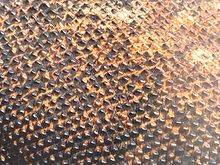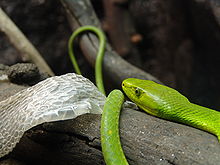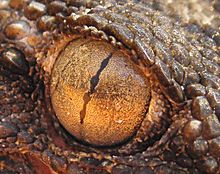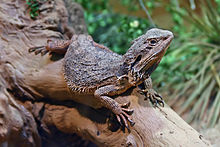Scaly creepers
| Scaly creepers | ||||||||||||
|---|---|---|---|---|---|---|---|---|---|---|---|---|

Scale reptiles ( Squamata ) |
||||||||||||
| Systematics | ||||||||||||
|
||||||||||||
| Scientific name | ||||||||||||
| Squamata | ||||||||||||
| Oppel , 1811 |
The Squamata ( squamates ) constitute one of the four major groups of reptiles (Reptilia). With 10,856 species (6827 " lizards ", 3828 snakes and 201 double snakes ; as of May 2020) they represent a significant part of the land vertebrate fauna, more than mammals with around 6400 species. Over 96% of the recent , known reptile species are scale reptiles.
Most squamats are medium-sized animals, the largest recent scale reptiles are the reticulated python ( Python reticulatus ) and the great anaconda ( Eunectes murinus ), which can reach a length of about eight to nine meters. The smallest is Brookesia micra , a stub - tailed chameleon that grows to just three centimeters . All scaled reptiles have a more or less elongated body, the cross-section of which is often round, but can also be flattened or high-backed (chameleons).
distribution
Scale reptiles colonize almost all terrestrial habitats. They live on all continents with the exception of Antarctica . With the sea snakes (Hydrophiinae) they also conquered the coastal region of tropical seas. Most scaled reptiles live in the tropics , towards the north the species abundance decreases more and more; they are absent in most of Canada , Alaska , Greenland and northern Siberia . The forest lizard ( Zootoca vivipara ) and the adder ( Vipera berus ) are the reptile species that penetrate furthest north. They can still be found north of the Arctic Circle . The most southern scale reptile is the iguana-like Liolaemus magellanicus , which still lives on Tierra del Fuego . There are just over 50 species of lizards and around 30 species of snakes in Europe. Twelve species live in Germany: five lizards , the blindworm and six snakes.
features
skin
The scaling of the epidermis (upper skin) can be very different. It is finest in geckos and can consist of flat, smooth or keeled shields, but it can also be provided with thorns or protruding humps. Iguana species often have blade-like spiky scales that form a crest on the neck, back, tail or on the dewlap . With some dune-dwelling lizards there are edges of protruding scales on the toes, which prevent them from sinking into the sand; These seams help the basilisks to walk quickly over the surface of water. Geckos and anoles have adhesive lamellae on the underside of their toes, which are formed by the epidermis and consist of many individual hairs.
The top layer of the epidermis does not grow with it and is stripped off regularly - every three to four weeks for many lizards or after six to ten months for snakes or chameleons. Before that, it was lifted by moulting hairs and separated from the new epidermis that had formed underneath with air or lymph fluid . Geckos eat them immediately after molting. Most lizards moult in tatters, snakes or legless lizards as a whole ( exuvia ). Rattlesnakes form a ring scale when molting, which becomes part of their tail rattle.
The dermis under the epidermis is thick and consists of three-dimensional bundles of connective tissue . In lizards, osteoderms (flat bone plates) are formed here, the shape and position of which roughly correspond to those of the scales above. The osteoderms can form a closed armor, especially in different types of skink but also in some crawling types . Under the dermis lies the subcutis , which rests loosely on the musculature and is formed by horizontally running connective tissue.
skull
The skull of the scaled reptiles differs from the diapsid skull in the reduction of the lower of the two zygomatic arches . The upper zygomatic arch is also regressed in the snakes, the double creeps and some legless skinky species. Another characteristic is the so-called streptostyly, the greatly increased internal mobility of the squamate's skull. This is achieved by the fact that the quadratum , a bone of the primary jaw joint of reptiles, rests flexibly on the scale bone . The mobility of the skull is most pronounced in snakes. Their lower jaw consists of two halved lower arches; The tooth-bearing dentals are not fused with one another at the front end, but are flexibly connected to one another by fiber cartilage ( symphysis ) and are also mobile in relation to the rest of the lower jaw bones. However, there is also a tendency, adapted to a digging way of life, to re-solidify the skull. This is particularly pronounced with the double snakes , the snake snakes and the blind snakes . In some digging skinks, belted lizards, real lizards and crusty lizards, the upper and lateral parts of the skull are additionally reinforced by small bone plates (osteoderms). The parietal foramen, an opening for the parietal organ in the roof of the skull, always remains free in the lizards. Snakes do not have a parietal organ.
Dentition

Tooth-bearing skull bones in the lizards are the maxillaria in the upper jaw and the dentalia in the lower jaw. In addition, the palatine bones can also bear teeth: the palatine bone (palatinum) in some sneaks, the wing bone (pterygoid) in some tejus and lizards, both bones in snakes. The teeth are rootlessly attached to the inside of the jawbone (pleurodontics). This is considered to be the plesiomorphism of scale reptiles. Replacement teeth grow from a bud at the base of the old teeth. In the agamas, the chameleons, the pointed-tailed double snakes (Trogonophidae) and the snakes, another form of tooth attachment occurs, the acrodontia. The teeth sit on the upper edge of the jaw. Agamas and chameleons are therefore grouped together within the iguanas as Monophylum Acrodonta. Squamats with acrodontic teeth do not change their teeth.
The teeth are usually homodontic (similar). Most squamats eat insects, their teeth are conical with one (geckos), two or three points (lizards, tejus, most iguanas). Mollusc-eating scale creepers, such as some skinks, creeps, tejus and monitor lizards, have wide, flattened teeth. The rear edge of large monitor lizards is finely sawn. Many herbivorous iguanas have flat-crowned teeth with serrated edges. In the thorn- tailed dragons , which also eat seeds and hard plant parts , the teeth have grown together to form a chewing bar. The teeth of the snakes are conical and curved backwards. The fangs of the venomous snakes are provided with a poison-conducting channel or a hollow channel. Vipers (Viperidae) and terrestrial vipers ( Atractaspididae) have teeth that are folded back when they are at rest and that are erected when their mouths are opened. In blind snakes (Typhlopidae), slender blind snakes (Leptotyphlopidae) and African egg snakes ( Dasypeltis ) the dentition is reduced.
Postcranial skeleton
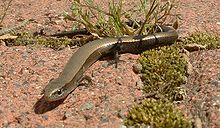
The skeleton of the scalloped reptiles has often been drastically changed to adapt to different ways of life. Most have five cervical vertebrae like chameleons, others like monitor lizards have up to nine. From the third cervical vertebra, there may be short ribs (cervical rib). The number of trunk vertebrae (vertebrae in front of the sacrum ) depends on the extension of the trunk and can be 23 to 29 in the geckos, 74 to 110 in the pinnipeds related to them . Skinky vertebrae have 26 to 107 trunk vertebrae, quadruped crawfish 29 to 36, their legless relatives 51 to 68. Snakes can have over 400 vertebrae, including up to 300 trunk vertebrae. All trunk vertebrae have ribs.
About shoulder girdle and forelimbs have, except for the two-foot-amphisbaenians (Bipedidae) and the Gymnophthalmidae genus bipes , only the four-legged species. It consists of the shoulder blade (scapula), raven bone (coracoid), collarbone (clavicle) and interclavicle. The last two are connected to the cartilaginous sternum . Two indentations in the raven bone, which in some forms have also broken through to windows, are considered squamate synapomorphism . The pelvic girdle consists of iliac (ilium), ischium (ischium) and the pubic bone (pubis). The three bones meet in the acetabulum together (acetabulum). The pelvic girdle is partially or completely reduced in the legless forms. Apart from the iguanas, the tendency to reduce limbs occurs in all taxa above the family level. Among the gecko-like there are the pinnipeds, with the skink-like there are forms with stunted legs with the skinks, with the belted lizards (genus Chamaesaura ) and with the dwarf Tejus (genera Bachia and Calyptommatus ). Some of the sneaks (Anguidae) and all ringed snakes (Anniellidae) have no limbs. The same goes for all 3000 species of snakes. Giant snakes still have a rod-shaped remnant of the pelvis in their abdomen and, with the anal spur, a rudimentary remnant of hind limbs .
Sense organs

The eyes are developed very differently depending on the species and can be found in nocturnal groups, e.g. B. various geckos , be very large, in others, such as some blind snake-like , almost completely reduced and without pigments. Nocturnal species have vertically oval to slit-shaped, diurnal species mostly round pupils . The very large orbits are separated by an interorbital septum (septum), the eyes are controlled by four straight and two oblique eye muscles and the retractor bulbi muscle . The eyeball is solidified around the cornea , in most scallops with the exception of snakes by a scleral ring . Lacrimal glands are present. The nictitating membrane is kept slippery by secretions from Harder's and nictitating membrane glands, in snakes and some other scaly creepers (such as many Gekkota) the nictitating membrane has grown together with the lower lid to form rigid “glasses”. Secretions from the aforementioned glands are drained into the oral cavity via lacrimal ducts or lacrimal ducts . The retina usually has only two or three different types of cones , some higher snakes also have rods . Some scaly creepers (e.g. Ahaetulla ) have the ability to see binocularly . Investigations into the night vision of the helmet gecko Tarentola chazaliaei showed that its eyes can distinguish colors at night when people are already color-blind. Perhaps this is due to the fact that there are only cones in his eyes.
When the mouth is closed, olfactory (chemical) perception takes place via the nostrils through an atrium to the actual nasal cavity with olfactory epithelium and inner nostril . The sensory epithelia are mostly located on the roof of the nasal cavity, and their area is enlarged by an outgrowth called a 'concha'. In this article, enlarged nasal glands are found in some scaled reptiles, often for salt excretion, for example in desert dwellers such as thorn- tailed dragons ( Uromastyx ) and the marine iguanas ( Amblyrhynchus cristatus ). The outer nostrils of some groups that are strongly bound to the water, such as sea snakes (Hydrophiinae), marine iguanas and water snakes (Homalopsinae) can be closed.
Another organ for olfactory perception is the Jacobson organ or vomeronasal organ. It arises in the embryo through a constriction of the nasal cavity and is later no longer connected to it. It opens through two passages to the roof of the mouth, and odor particles are then transported at the tip of the tongue to the sensory epithelia of the vomeronasal organ. The odor particles are picked up by regularly moving the tongue out and back in the mouth; this process, which is particularly common with monitor lizards ( varanus ) and snakes, is called 'tonguing'.
Taste buds are mainly found on the tongue, but also on the roof of the mouth and on the oral mucosa . In snakes, taste buds are only present on the lining of the mouth. For a long time it was debated whether squamats use their sense of taste. In an experiment carried out in 2001 dial disdained Carolina anole ( Anolis carolinensis ) provided with feeding insects bitter substances while using sweetener provided insects were preferred over normal tasting insects. These preferences were retained even with blocked passages of the vomeronasal organ. Thus the sense of taste in reptiles that do not primarily use the vomeronasal organ could play a role in the selection of prey. Lizards like the Lacerta genus can evidently distinguish between all four taste qualities (sweet, sour, salty, bitter).
The hearing organ consists of the outer ear , tympanic cavity and inner ear . The eardrum is almost always at the level of the lateral surface of the head. In some scalloped crawfish, the outer ear is reduced because the eardrum is covered with the scaly skin, or the pit edges of the tympanum are fused with the eardrum.
In 2010 it was also experimentally confirmed that the gecko Cyrtodactylus philippinicus can orient itself on the earth's magnetic field . This was the first evidence of a magnetic sense in scale creeps.
Reproduction


Scale reptiles have internal fertilization and mate from the side. Depending on which side the male is on, the right or left hemipenis is used. During mating, the males of most lizards and some species of snakes (not poisonous snakes) hold onto the neck or flank of the female with their mouths. Giant snakes entwine themselves with their abdomen while mating.
The majority of scale reptiles lay eggs. The eggs have a parchment-like shell and can expand during incubation due to the absorption of water. For most Gecko-like , with the exception of eublepharinae , diplodactylidae , carphodactylidae and fins feet , the eggshells are however calcified. Viviparia and ovoviviparia have developed several times, independently of one another, in different taxa, for example in some skinks , all niggas , some sneaks , boas and sand boas , almost all sea snakes and numerous vipers . A surprisingly high number of scale reptiles reproduce through parthenogenesis . First, this phenomenon has been in the Caucasian rock lizards ( Darevskia discovered), but also comes with four gecko species, the cnemidophorus ( Cnemidophorus ), two species of gymnophthalmidae , the leiolepis ( Leiolepis ), the Central American Night lizards ( Lepidophyma ) and in the blind snake Ramphotyphlops braminus ago . Only a few snakes like pythons do brood care . They lie in loops around their clutch until the young animals hatch and generate heat by trembling muscles. As with turtles and crocodiles , the sex of some lizards is determined by the temperature during the last third of the incubation period. When the incubation temperature is high, males are produced; when it is lower, females. The hatchlings of all egg-laying squamats free themselves from the egg shell with an egg tooth . Hatching can take a few hours to days. The young animals do not leave the egg until the yolk sac has moved in. After hatching, the animals are immediately independent and resemble the adults . Only a different juvenile drawing occurs.
Systematics
External system
The scalloped reptiles belong to the diapsid reptiles whose skull is characterized by two skull windows. Their sister group , with which it and in the superiority lepidosauria are combined (Lepidosauria), the Sphenodontia . In addition to the bridge lizards from New Zealand that are still alive today, these only include taxa from the Mesozoic era . The monophyly of the Lepidosauria is secured by almost 50 synapomorphies .
| Sauropsida ( Reptilia ) |
|
||||||||||||||||||
|
|
Internal system
The internal systematics of the scalloped reptiles is discussed in contradicting terms by various processors and is still to be regarded as very preliminary. Classically, the scale reptiles were divided into two sub-orders, the lizards (Lacertilia) and the snakes (Serpentes). Later, the double snakes (Amphisbaenia), which because of their burrowing way of life, have a physique that differs greatly from the other groups of lizards, were added as a separate subordination. Since the last-named groups emerged from the lizards, the lizards are a paraphyletic taxon . In this group all scaled reptiles were combined that could not be assigned to the other two groups. Double snakes and snakes are considered monophyletic.
A morphological division of the lizards into four groups can be found in many publications. The iguanas , which also include agamas and chameleons , are the lowest clade at the origin of the family tree. All other lizards belong to the taxon Scleroglossa, whose monophyly is supported by more than 20 autapomorphies . These are divided into the gecko-like , which in addition to geckos and the legless pygopodidae from Australia and New Guinea are, and the Autarchoglossa that are characterized by the possession of a rectus abdominis distinguished. The autarchoglossa are divided into skinky and creeping . The real lizards native to Europe belong to the skink-like species . Many scientists also count the double creeps and the also legless snake snakes . In addition to the sneaks, the sneak-like monitors also include the large monitor lizards and the lizards . Since the monitor lizards share a number of characteristics with the snakes, these are also regarded by many experts as creeping. In the classical systematics, the snakes have the rank of subordination and are divided into three superfamilies: the primitive, burrowing and underground blind snake-like , the burrowing and giant snake-like , to which the giant snakes belong in addition to some largely unknown families , as well as the adder and Viper-like , which with well over 2000 species makes up the great mass of snakes. The system of snakes is also subject to major changes, which is why the paraphyletic superfamily of the burrowing and giant snake-like is no longer valid.
The following simple cladogram reproduces this classic concept of the relationship within the scale reptiles (largely based on W. Böhme, 2004):
| Scaly creepers |
|
|||||||||||||||||||||||||||
|
|

According to the most recent molecular biological investigations, the relationship between the large taxa of the scalloped reptiles is being questioned and the monophyly of the scleroglossa, the autarchoglossa and the skinky (Scincomorpha) are disputed. This results in a completely different family tree, which can now be based on some anatomical features. The snakes are at the base of the cladogram; they are the only scaled crawlers to have a single-pointed tongue. All other scaled reptiles are placed in the new taxon Bifurcata. The bifurcata have a two-pointed tongue that varies in extent and can only be slightly notched, as in the case of the geckos , or in the other extreme deeply split, as in the case of Tejus , monitor lizards and snakes . The only exception to this are the chameleons , whose tongue has been transformed into a highly specialized catching device. The bifurcata divide in a dichotomy into the gecko-like, whose hatchlings have a pair of egg teeth , and the unidentata, which have only one egg tooth. Within the Unidentata, a distinction is made between Scinciformata and Episquamata. Among the Scinciformata include skinks , the belt lizards and night lizards . The Episquamata consist of the Laterata, to which some families otherwise belong to the Skinky family, and the Toxicofera .
After toxicofera concept is the ability of toxic Squamata like the beaded lizards , the fanged snakes and vipers , toxins produce not more than once, but emerged only once in a common ancestor approximately 200 to 230 million years ago. The Toxicofera include the snakes, the crawling and the iguana; the latter two are sister groups. The snakes do not belong here to the crawl- like, as in the above-mentioned cladogram, which was created according to morphological criteria; the iguanas are not at the base of the cladogram, but are located high up in the crown group . The Toxicofera concept receives further support, since poison-producing glandular tissue has also been found in the upper and lower jaw of an iguana-like species, the Eastern Bearded Dragon ( Pogona barbata ). In addition, the symptoms that occur after the bites of three types of monitor lizard are no longer interpreted as the result of a bacterial infection, but as the result of active poisonous secretion.
Cladogram of the scalloped reptiles according to molecular biological studies:
|
Tribal history
The first lizards similar to scaled reptiles appear in the Upper Permian and Lower Triassic of South Africa . Other fossils have been found in layers of the Upper Triassic in England and North America . Their skeleton is much more primitive than that of the recent taxa. Therefore, they are classified as a separate taxon Eolacertilia . They quickly conquered new habitats and displaced the previously dominant lizard-like reptiles such as the procolophonians , millerosaurs and eosuchians .
Almost no squamate fossils are known from the Jurassic period . It was not until the late Jurassic that fossils were found again in China and Europe. These can be assigned to today's large taxa Gekkota , Scincomorpha and Anguimorpha . The Euposaurus found in France is due to its acrodont teeth (on the upper edge of the jaw) in the relationship of the agam to the iguanas . The slippery Xianglong from the Lower Cretaceous of China belongs to the same family group . The Tejus appeared with numerous species in the Upper Cretaceous of North America and Central Asia. From the same time, the first coming crawl , Xenosauriden , beaded lizards and monitor lizards , as well as Dinislysia from Patagonia , the first well-known snake. The snake Pachyrhachis found in Israel has more than 200 ribs, stunted pelvic girdles and hind legs, but has completely lost front legs and shoulder girdles. Overall, the tradition of snake fossils from the Cretaceous and the Lower Tertiary is very sketchy. The Upper Cretaceous is also the heyday of marine squamats, such as the aigialosaurs and the giant mosasaurs , which existed in the oceans with almost 20 genera and reached lengths of up to 18 meters. The skulls of both groups resembled lizard skulls, but they also show anatomical similarities with giant snakes . Both taxa fell victim to the Cretaceous-Tertiary Frontier mass extinction 65 million years ago.
The first fossils of double snakes are from the Paleocene . Blind snakes and snakes appear in the Eocene , vipers and poisonous snakes in the Miocene . The radiation from snakes probably coincides with the spread of small mammals , an important prey. The chameleon can be detected since the Miocene in Europe and Africa.
swell
Main source for the article is:
- Wolfgang Böhme: Squamata, scale reptiles. In: Wilfried Westheide, Reinhard Rieger (Ed.): Vertebral or skull animals. (= Special Zoology. Part 2). Fischer, Stuttgart 2004, ISBN 3-8274-0900-4 , pp. 354-357.
Source for the chapter on tribal history is:
- Robert L. Carroll: Paleontology and Evolution of the Vertebrates. Thieme, Stuttgart 1993, ISBN 3-13-774401-6 .
Everything not covered by these works will be substantiated by individual records.
- ^ Squamata in The Reptile Database
- ^ Sauria in The Reptile Database
- ^ Serpentes in The Reptile Database
- ^ Amphisbaenia in The Reptile Database
- ↑ a b c Nicolas Vidal, S. Blair Hedges: The phylogeny of squamate reptiles (lizards, snakes, and amphisbaenians) inferred from nine nuclear protein-coding genes. (PDF; 164 kB). In: Comptes Rendus Biologies. 328, No. 10-11, 2005, pp. 1000-1008, doi: 10.1016 / j.crvi.2005.10.001 .
- ^ Günter Diesner, Josef Reichholf: Lurche und Kriechtiere. Mosaik, Munich 1996, ISBN 3-576-10697-9 .
- ↑ LSV Roth, L. Lundström, A. Kelber, RHH Kröger, P. Unsbo: The pupils and optical systems of gecko eyes. In: Journal of Vision. 9 (3), 2009, pp. 1–11 ( full text ; PDF; 541 kB).
- ↑ Kathrin F. Stanger-Hall, Derek A. Zelmer, Christine Bergren, Stephanie A. Burns: Taste Discrimination in a Lizard (Anolis carolinensis, Polychrotidae). In: Copeia. (2), 2001, pp. 490-498.
- ↑ C. Marek, N. Bissantz, E. Curio, A. Siegert, B. Tacud & D. Ziggel: Spatial orientation of the Philippine bent-toed gecko (Cyrtodactylus philippinicus) in relation to its home range. In: Salamandra. Volume 46, No. 2, 2010, pp. 93-97, full text .
- ^ Nicolas Vidal, S. Blair Hedges: Molecular evidence for a terrestrial origin of snakes. (PDF; 192 kB). In: Proceedings. Biological sciences. 271, 2004, pp. 226-S229. PMID 15252991 .
- ^ A b Ted M. Townsend, Allan Larson, Edward Louis, J. Robert Macey: Molecular phylogenetics of squamata: The position of snakes, amphisbaenians, and dibamids, and the root of the squamate tree. In: Systematic Biology. 53, No. 5, 2004, pp. 735-757, doi: 10.1080 / 10635150490522340 .
- ^ BG Fry, N. Vidal, JA Norman, FJ Vonk, H. Scheib, SF Ramjan, S. Kuruppu, K. Fung, SB Hedges, MK Richardson, WC Hodgson, V. Ignjatovic, R. Summerhayes, E. Kochva: Early evolution of the venom system in lizards and snakes. In: Nature. Volume 439, number 7076, February 2006, pp. 584-588, doi: 10.1038 / nature04328 . PMID 16292255 .
- ↑ Robert Alexander Pyron, Frank T. Burbrink, John J Wiens: A phylogeny and revised classification of Squamata, including 4161 species of lizards and snakes. In: BMC Evolutionary Biology. 2013, 13, p. 93 doi: 10.1186 / 1471-2148-13-93 .
- ↑ Nicolas Vidal, Anna Azvolinsky, Corinne Cruaud, S. Blair Hedges: Origin of tropical American burrowing reptiles by transatlantic rafting. In: Biology Letters. Volume 4, No. 1, 2008, pp. 115-118, doi: 10.1098 / rsbl.2007.0531 .
- ↑ N. Goicoechea, DR Frost, I. De la Riva, KCM Pellegrino, J. Sites, MT Rodrigues, JM Padial: Molecular systematics of teioid lizards (Teioidea / Gymnophthalmoidea: Squamata) based on the analysis of 48 loci under tree-alignment and similarity alignment. In: Cladistics. March 2016, doi: 10.1111 / cla.12150
- ^ Pi-Peng Li, Ke-Qin Gao, Lian-Hai Hou, Xing Xu: A gliding lizard from the Early Cretaceous of China. In: Proceedings of the National Academy of Sciences. 104, No. 13, 2007, pp. 5507-5509, doi: 10.1073 / pnas.0609552104 .

